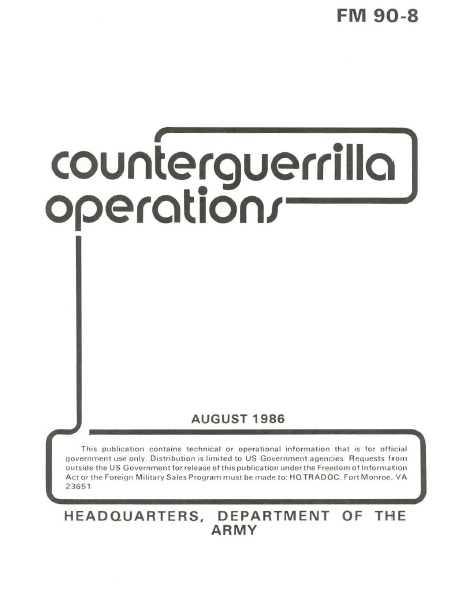This is the most recent available version of the U.S. Army’s Counterguerrilla Operations field manual. For a more recent view of related doctrine, see the U.S. Army’s Guerrilla Hunter Killer Smartbook.
Counterguerrilla Operations
- FM 90-8
- 257 pages
- August 1986
The aims, objectives, and methods of guerrilla warfare differ greatly from those of conventional warfare. To be successful in countering this type of war, the planners of counterguerrilla operations must understand the enemy and the unique environment in which he operates.
This manual provides commanders and staffs of brigade elements and below with concepts and doctrine concerning the conduct of counterguerrilla operations by US forces in insurgency and conventional conflict environments. It provides a general overview of US counterinsurgency strategy and the impact that strategy has on counterguerrilla operations. It provides planning, training, and operational guidance for commanders and staffs conducting counterguerrilla operations. The doctrine provides principles to guide the actions of US forces conducting counterguerrilla operations. In applying these principles, the commander must be aware that the situation in each counterguerrilla operation is unique. Techniques and tactics applied successfully in one situation may not be suitable if applied in the same manner in another situation. The principles in this manual are guides to be adapted to each counterguerrilla situation.
…
1-2. Types of conflict.
a. The risk to national survival is greatest in a conventional conflict, but the probability of such conflicts occurring is relatively low. On the other hand, the risk to national survival is not as great in a counterinsurgency conflict, but the probability of these types of conflicts occurring is much greater.
b. Conventional conflicts imply a state of open belligerency between nations and a direct confrontation of their armed forces. An insurgency implies a situation where a country is threatened by an internal attempt, frequently assisted by external support, to overthrow the legitimate government. counterguerrilla situations faced by US forces are likely to occur in an insurgency environment, but may also occur in conventional conflict environments. Counterguerrilla operations in support of a conventional conflict (such as the partisan operations that occurred behind German lines during World War II) are discussed in Chapter 4.
Section II. Insurgency
1-3. Concept.
a. The concept of resistance applies to an organized effort by some portion of the civil population of a country to resist, oppose, or overthrow the existing government. Many of the methods of resistance are part of the stock-in-trade of revolutionary activity. There can be no revolution without a resistance movement, but there can be a resistance movement without a revolution when the objectives of the resistors do not envision a reallocation of power.
b. This concept applies to an organized insurgent movement that seeks to overthrow the established government. In this manner, an insurgent organization can be considered a type of resistance organization.
1-4. Prerequisites.
There are three requirements that must exist before an insurgency can occur.
a. Vulnerable population. For whatever the reasons — social, political, or economic — the population is generally open to change. The insurgents will offer hope for change and exploit dissatisfaction with the current government.
b. Leadership available for direction. A vulnerable population alone will “not support an insurgent movement. There must be a leadership element that can direct the frustrations of a dissatisfied populace along the lines delineated by the overall insurgent strategy.
c. Lack of government control. Lack of government control may be real or perceived. The greater the control the government has over the situation, the less likely are the chances for insurgent success The opposite is also true: the less control the government has, the greater is the chance for insurgent success.

